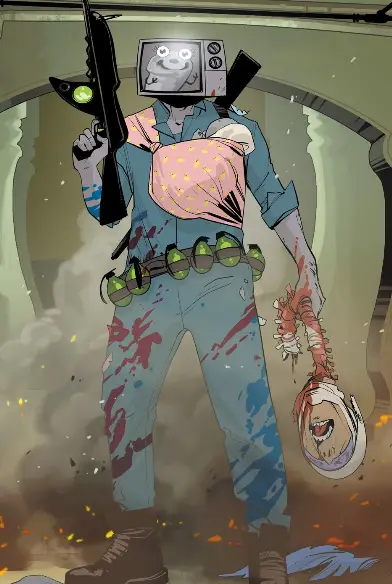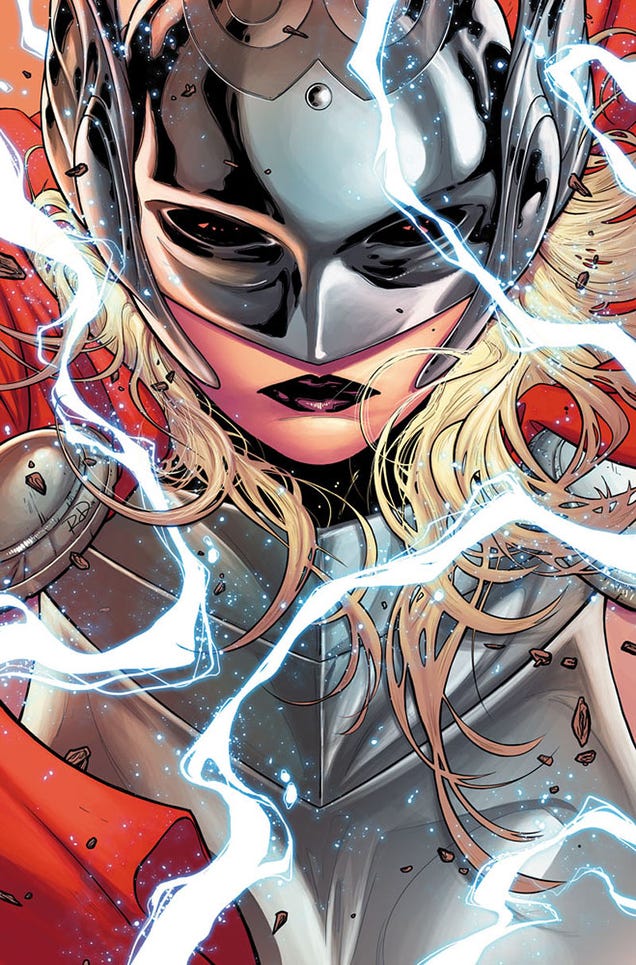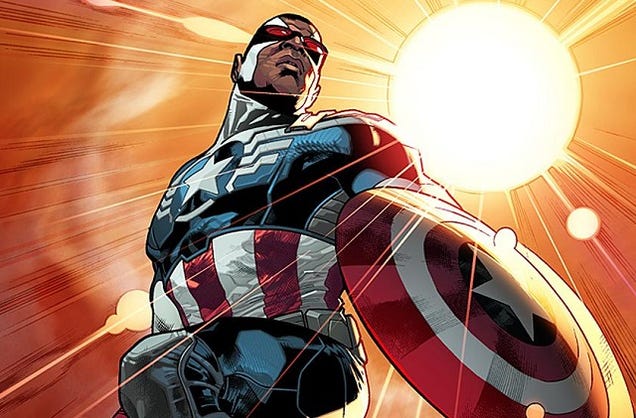Because everyone else is doing it. Mostly Marvel lately (big shock), and behind on some titles.
Wolverine and Deadpool #1 (Marvel/Panini)
 As with everyone else, Panini are
jumping on board the obligatory renumbering of issues. Wolverine
and Deadpool has been their
major bumper title for some time now, bundling the reprints of the
two series for the UK market. So this review is particularly behind,
since this stuff was published in the States back in January. Anyway,
it's a good format, bringing two of the butchest, boysiest titles
together. The Wolverine segment takes up the bulk of the issue,
reprinting the beginning of Savage Wolverine.
The Savage Land is an obvious place to dump Logan, and begins with a
brilliant image of him fighting a feathery Velociraptor.
Then Shanna the She-Devil gets involved, in her ludicrously skimpy
costume. She's actually a fine, strong character with a decent wit,
so it's a shame she has to parade around in nothing more than a
couple of strips of leopardskin. So yes, it's blood, boobs and
talking pterodactyls. The Deadpool story is better, a dirty, witty
story involving the resurrection of dead presidents in a twisted
attempt to save America. Good stuff.
As with everyone else, Panini are
jumping on board the obligatory renumbering of issues. Wolverine
and Deadpool has been their
major bumper title for some time now, bundling the reprints of the
two series for the UK market. So this review is particularly behind,
since this stuff was published in the States back in January. Anyway,
it's a good format, bringing two of the butchest, boysiest titles
together. The Wolverine segment takes up the bulk of the issue,
reprinting the beginning of Savage Wolverine.
The Savage Land is an obvious place to dump Logan, and begins with a
brilliant image of him fighting a feathery Velociraptor.
Then Shanna the She-Devil gets involved, in her ludicrously skimpy
costume. She's actually a fine, strong character with a decent wit,
so it's a shame she has to parade around in nothing more than a
couple of strips of leopardskin. So yes, it's blood, boobs and
talking pterodactyls. The Deadpool story is better, a dirty, witty
story involving the resurrection of dead presidents in a twisted
attempt to save America. Good stuff.
Ghostbusters #17 (IDW)
It's the thirtieth anniversary of Ghostbusters, so Burnham and his team are going all out. Finally, they are able to use Dana Barrett, seemingly unable to do so previously due to likeness rights or somesuch. It's only right that she be added to the growing cast of characters; her absence was the one thing missing from this follow-up. Burnham's story questions just why Dana was so integral to the manifestation of two powerful spirits, an obvious question and one that is well overdue for exploration. Dan Schoening's artwork is better than ever, his take on Dana is as perfect as his Vigo and Gozer, both of whom make their presences felt in this, the fifth chapter of the “Mass Hysteria” stroyline. Plus, there's Timothy Lim's beautiful memorial artwork to the late Harold Ramis.
Saga #20-21 (Image)
Saga was beginning to feel that it was treading water with the first few issues of its third run. Never anything less than well-written and beautifully produced, but nonetheless not really going anywhere. Continuing to bate the censors with sex, drugs and violent death, it really feels like the events in this galaxy are reaching tipping point with the shocking assassination of a major figure. All the while, focus is on Hazel and her mismatched family. As good as Brian K. Vaughan's writing is, and it is very good, it's Fiona Staples's astonishing artwork that makes this such a phenomenal read. Visceral, beautiful, other-worldly and relatable in equal measure, this remains an excellent series.
Captain Marvel #1-3 (Marvel)
Marvel's premier female superhero head her own title in fine style. The first couple of issues are fairly frothy stuff, with most of the drama stemming from Carol Danvers's personal issues, such as her relationship with Rhodey and the intense strain she puts it under by opting to go on a year long mission into space. The galactic vista suits such a powerful character, and by issue three Danvers is discovering that simply stepping in to help doesn't always go down well with other cultures. So yes, it's about America and international relations. It's a hell of a lot subtler and more fun than previous attempts at this sort of thing by Marvel, though (The Ultimates, in particular). Plus, the Guardians of the Galaxy continue their rise with a major appearance in this series.
Ms. Marvel #6 (Marvel)
Meanwhile, Danvers's former title is handed down to her biggest fan, young Kamala Khan. Rightly praised by most fans, and predictably attacked by the hard right, having a young American Muslim get her own comics title is an excellent move, providing it can be written with intelligence and sensitivity. Thankfully, G. Willow Wilson is providing just that. This is a truly excellent superhero story, using a mysterious origin story to explore a number of significant issues, including cultural and personal identity, the life of an outsider, image problems and the need for strong female role models. Just what a Marvel comic should be doing. Issue six starts the second story, entitled “Healing Factor,” which gives Kamala her first team-up with her absolute number one favourite, Wolverine. Along with some fabulously weird villains. This is a cracking title.
Amazing Spider-Man #1 including Inhuman #1 (Marvel)
So, there's going to be a lot of Spider-Man this year. This bumper-sized issue begins yet another “Issue One,” to one of Marvel's longest-running titles, starting afresh after the Superior Spider-Man series which, I confess, I had little interest in. While there are still consequences for Parker from that series, new elements are introduced, including another recipient of a radioactive spider bite. The issue also chucks in little prequel tales for Spider-Man 2099 and further origin stories to be explored in Issue 1.1 onwards, as Marvel does bizarre things to its numbering system. And all this has to tie in to the Original Sin event, which I can't really be bothered with. Still, this is good fun Spidey stuff and the only thing keeping me from immediately going further is the plethora of extra titles involved. Nonetheless, the “Spider-Verse” storyline it's building to does excite me. The first issue of Inhuman is included, which is actually very good and sets up some interesting things for new Avenger Medusa, and Dante, a newly altered Inhuman. Joe Madureira's art is gorgeous.
Rocket Raccoon #1 (Marvel)
With the Guardians of the Galaxy movie imminent (cannot wait), the relaunched comic line is sprouting its own spin-offs. Naturally, the furriest, most popular member of the team gets his own title. There are a couple of flaws – it desperately wants to be allowed to swear, for a start – but this is anarchic, joyfully aggressive fun. Star-spanning shenanigans give way to something with a bit of a John Tucker Must Die vibe. With script and art from Skottie Young, supported by excellent colours from Jean-Francois Beaulieu, this is a fantastic looking book. It also comes with a free comics download code. Mine didn't work.
Doctor Who: The Tenth Doctor #1 and The Eleventh Doctor #1 (Titan)
Titan Comics are the latest holders of the Doctor Who licence, thankfully not bound by the same franchise issues that stopped IDW selling their series in the UK. Of the two, the eleventh Doctor series is the better. Al Ewing has written a beautiful script that tackles depression and loneliness, while still managing to tell a fun, silly adventure, and he captures the eleventh Doctor perfectly. His new companion, Alice Obiefune, is excellently characterised, and the Doctor takes her travelling for the best reason of all: because she needs cheering up. Nick Abadzis writes the tenth Doctor story, preferring to go for the first part of a serial and ending on a cliffhanger. It's not as good an introduction to its new companion, Mexican American girl Gabriela, but it works well enough and she's a likeably spirited character. There are some surprisingly creepy and unpleasant visual moments to, in a story that goes for horror over whimsy. It's good that the two series take different approaches to their stories, and I can only applaud the multiethnic characters. A good start to the latest in a long run of Doctor Who comics. A twelfth Doctor series is due later in the year.
Wolverine and Deadpool #1 (Marvel/Panini)
 As with everyone else, Panini are
jumping on board the obligatory renumbering of issues. Wolverine
and Deadpool has been their
major bumper title for some time now, bundling the reprints of the
two series for the UK market. So this review is particularly behind,
since this stuff was published in the States back in January. Anyway,
it's a good format, bringing two of the butchest, boysiest titles
together. The Wolverine segment takes up the bulk of the issue,
reprinting the beginning of Savage Wolverine.
The Savage Land is an obvious place to dump Logan, and begins with a
brilliant image of him fighting a feathery Velociraptor.
Then Shanna the She-Devil gets involved, in her ludicrously skimpy
costume. She's actually a fine, strong character with a decent wit,
so it's a shame she has to parade around in nothing more than a
couple of strips of leopardskin. So yes, it's blood, boobs and
talking pterodactyls. The Deadpool story is better, a dirty, witty
story involving the resurrection of dead presidents in a twisted
attempt to save America. Good stuff.
As with everyone else, Panini are
jumping on board the obligatory renumbering of issues. Wolverine
and Deadpool has been their
major bumper title for some time now, bundling the reprints of the
two series for the UK market. So this review is particularly behind,
since this stuff was published in the States back in January. Anyway,
it's a good format, bringing two of the butchest, boysiest titles
together. The Wolverine segment takes up the bulk of the issue,
reprinting the beginning of Savage Wolverine.
The Savage Land is an obvious place to dump Logan, and begins with a
brilliant image of him fighting a feathery Velociraptor.
Then Shanna the She-Devil gets involved, in her ludicrously skimpy
costume. She's actually a fine, strong character with a decent wit,
so it's a shame she has to parade around in nothing more than a
couple of strips of leopardskin. So yes, it's blood, boobs and
talking pterodactyls. The Deadpool story is better, a dirty, witty
story involving the resurrection of dead presidents in a twisted
attempt to save America. Good stuff.Ghostbusters #17 (IDW)
It's the thirtieth anniversary of Ghostbusters, so Burnham and his team are going all out. Finally, they are able to use Dana Barrett, seemingly unable to do so previously due to likeness rights or somesuch. It's only right that she be added to the growing cast of characters; her absence was the one thing missing from this follow-up. Burnham's story questions just why Dana was so integral to the manifestation of two powerful spirits, an obvious question and one that is well overdue for exploration. Dan Schoening's artwork is better than ever, his take on Dana is as perfect as his Vigo and Gozer, both of whom make their presences felt in this, the fifth chapter of the “Mass Hysteria” stroyline. Plus, there's Timothy Lim's beautiful memorial artwork to the late Harold Ramis.
Saga #20-21 (Image)
Saga was beginning to feel that it was treading water with the first few issues of its third run. Never anything less than well-written and beautifully produced, but nonetheless not really going anywhere. Continuing to bate the censors with sex, drugs and violent death, it really feels like the events in this galaxy are reaching tipping point with the shocking assassination of a major figure. All the while, focus is on Hazel and her mismatched family. As good as Brian K. Vaughan's writing is, and it is very good, it's Fiona Staples's astonishing artwork that makes this such a phenomenal read. Visceral, beautiful, other-worldly and relatable in equal measure, this remains an excellent series.
Captain Marvel #1-3 (Marvel)
Marvel's premier female superhero head her own title in fine style. The first couple of issues are fairly frothy stuff, with most of the drama stemming from Carol Danvers's personal issues, such as her relationship with Rhodey and the intense strain she puts it under by opting to go on a year long mission into space. The galactic vista suits such a powerful character, and by issue three Danvers is discovering that simply stepping in to help doesn't always go down well with other cultures. So yes, it's about America and international relations. It's a hell of a lot subtler and more fun than previous attempts at this sort of thing by Marvel, though (The Ultimates, in particular). Plus, the Guardians of the Galaxy continue their rise with a major appearance in this series.
Ms. Marvel #6 (Marvel)
Meanwhile, Danvers's former title is handed down to her biggest fan, young Kamala Khan. Rightly praised by most fans, and predictably attacked by the hard right, having a young American Muslim get her own comics title is an excellent move, providing it can be written with intelligence and sensitivity. Thankfully, G. Willow Wilson is providing just that. This is a truly excellent superhero story, using a mysterious origin story to explore a number of significant issues, including cultural and personal identity, the life of an outsider, image problems and the need for strong female role models. Just what a Marvel comic should be doing. Issue six starts the second story, entitled “Healing Factor,” which gives Kamala her first team-up with her absolute number one favourite, Wolverine. Along with some fabulously weird villains. This is a cracking title.
Amazing Spider-Man #1 including Inhuman #1 (Marvel)
So, there's going to be a lot of Spider-Man this year. This bumper-sized issue begins yet another “Issue One,” to one of Marvel's longest-running titles, starting afresh after the Superior Spider-Man series which, I confess, I had little interest in. While there are still consequences for Parker from that series, new elements are introduced, including another recipient of a radioactive spider bite. The issue also chucks in little prequel tales for Spider-Man 2099 and further origin stories to be explored in Issue 1.1 onwards, as Marvel does bizarre things to its numbering system. And all this has to tie in to the Original Sin event, which I can't really be bothered with. Still, this is good fun Spidey stuff and the only thing keeping me from immediately going further is the plethora of extra titles involved. Nonetheless, the “Spider-Verse” storyline it's building to does excite me. The first issue of Inhuman is included, which is actually very good and sets up some interesting things for new Avenger Medusa, and Dante, a newly altered Inhuman. Joe Madureira's art is gorgeous.
Rocket Raccoon #1 (Marvel)
With the Guardians of the Galaxy movie imminent (cannot wait), the relaunched comic line is sprouting its own spin-offs. Naturally, the furriest, most popular member of the team gets his own title. There are a couple of flaws – it desperately wants to be allowed to swear, for a start – but this is anarchic, joyfully aggressive fun. Star-spanning shenanigans give way to something with a bit of a John Tucker Must Die vibe. With script and art from Skottie Young, supported by excellent colours from Jean-Francois Beaulieu, this is a fantastic looking book. It also comes with a free comics download code. Mine didn't work.
Doctor Who: The Tenth Doctor #1 and The Eleventh Doctor #1 (Titan)
Titan Comics are the latest holders of the Doctor Who licence, thankfully not bound by the same franchise issues that stopped IDW selling their series in the UK. Of the two, the eleventh Doctor series is the better. Al Ewing has written a beautiful script that tackles depression and loneliness, while still managing to tell a fun, silly adventure, and he captures the eleventh Doctor perfectly. His new companion, Alice Obiefune, is excellently characterised, and the Doctor takes her travelling for the best reason of all: because she needs cheering up. Nick Abadzis writes the tenth Doctor story, preferring to go for the first part of a serial and ending on a cliffhanger. It's not as good an introduction to its new companion, Mexican American girl Gabriela, but it works well enough and she's a likeably spirited character. There are some surprisingly creepy and unpleasant visual moments to, in a story that goes for horror over whimsy. It's good that the two series take different approaches to their stories, and I can only applaud the multiethnic characters. A good start to the latest in a long run of Doctor Who comics. A twelfth Doctor series is due later in the year.





